Practice Free AZ-104 Exam Online Questions
You deploy an Azure Kubernetes Service (AKS) cluster named Cluster1 that uses the IP addresses shown in the following table.

You need to provide internet users with access to the applications that run in Cluster1.
Which IP address should you include in the DNS record for Ousted?
- A . 172.17.7.1
- B . 131.107.2.1
- C . 192.168.10.2
- D . 10.0.10.11
B
Explanation:
When any internet user will try to access the cluster which is behind a load balancer, traffic will first hit to load balancer front end IP. So in the DNS configuration you have to provide the IP address of the load balancer.
Reference: https://stackoverflow.com/questions/43660490/giving-a-dns-name-to-azure-load-balancer
You deploy an Azure Kubernetes Service (AKS) cluster named Cluster1 that uses the IP addresses shown in the following table.

You need to provide internet users with access to the applications that run in Cluster1.
Which IP address should you include in the DNS record for Ousted?
- A . 172.17.7.1
- B . 131.107.2.1
- C . 192.168.10.2
- D . 10.0.10.11
B
Explanation:
When any internet user will try to access the cluster which is behind a load balancer, traffic will first hit to load balancer front end IP. So in the DNS configuration you have to provide the IP address of the load balancer.
Reference: https://stackoverflow.com/questions/43660490/giving-a-dns-name-to-azure-load-balancer
HOTSPOT
You need to configure Azure Backup to meet the technical requirements for cont1 and share1.
To what should you set the backup frequency for each resource? To answer, select the appropriate options in the answer area. NOTE: Each correct selection is worth one point.

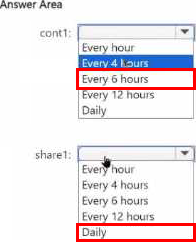
You have a registered DNS domain named contoso.com.
You create a public Azure DNS zone named contoso.com.
You need to ensure that records created in the contoso.com zone are resolvable from the internet.
What should you do?
- A . Modify the NS records in the DNS domain registrar.
- B . Create NS records in contoso.com.
- C . Create the SOA record in contoso.com.
- D . Modify the SOA record in the DNS domain registrar.
You have an Azure Active Directory (Azure AD) tenant named contoso.com.
You have a CSV file that contains the names and email addresses of 500 external users.
You need to create a guest user account in contoso.com for each of the 500 external users.
Solution: You create a Power Shell script that runs the New-MgUser cmdlet for each user.
Does this meet the goal?
- A . Yes
- B . NO
B
Explanation:
The New-MgUser cmdlet is part of the Microsoft Graph PowerShell SDK, which is a module that allows you to interact with the Microsoft Graph API. The Microsoft Graph API is a service that provides access to data and insights across Microsoft 365, such as users, groups, mail, calendar, contacts, files, and more1.
The New-MgUser cmdlet can be used to create new users in your Azure AD tenant, but it has some limitations and requirements. For example, you need to have the Global Administrator or User Administrator role in your tenant, you need to authenticate with the Microsoft Graph API using a certificate or a client secret, and you need to specify the required parameters for the new user, such as userPrincipalName, accountEnabled, displayName, mailNickname, and passwordProfile2. However, the New-MgUser cmdlet does not support creating guest user accounts in your Azure AD tenant. Guest user accounts are accounts that belong to external users from other organizations or domains. Guest user accounts have limited access and permissions in your tenant, and they are typically used for collaboration or sharing purposes3.
To create guest user accounts in your Azure AD tenant, you need to use a different cmdlet: New-AzureADMSInvitation. This cmdlet is part of the Azure AD PowerShell module, which is a module that allows you to manage your Azure AD resources and objects. The New-AzureADMSInvitation cmdlet can be used to create and send an invitation email to an external user, which contains a link to join your Azure AD tenant as a guest user. You can also specify some optional parameters for the invitation, such as the invited user display name, message info, redirect URL, or send invitation message.
Therefore, to meet the goal of creating guest user accounts for 500 external users from a CSV file, you need to use a PowerShell script that runs the New-AzureADMSInvitation cmdlet for each user, not the New-MgUser cmdlet.
You have an Azure subscription.
You plan to create a storage account named storage1.
You need to configure a deny assignment for storage1.
What should you use?
- A . an Azure Resource Manager (ARM) template
- B . Azure Policy
- C . a landing zone
- D . a deployment stack
HOTSPOT
You have a virtual network named VNet1 that has the configuration shown in the following exhibit.
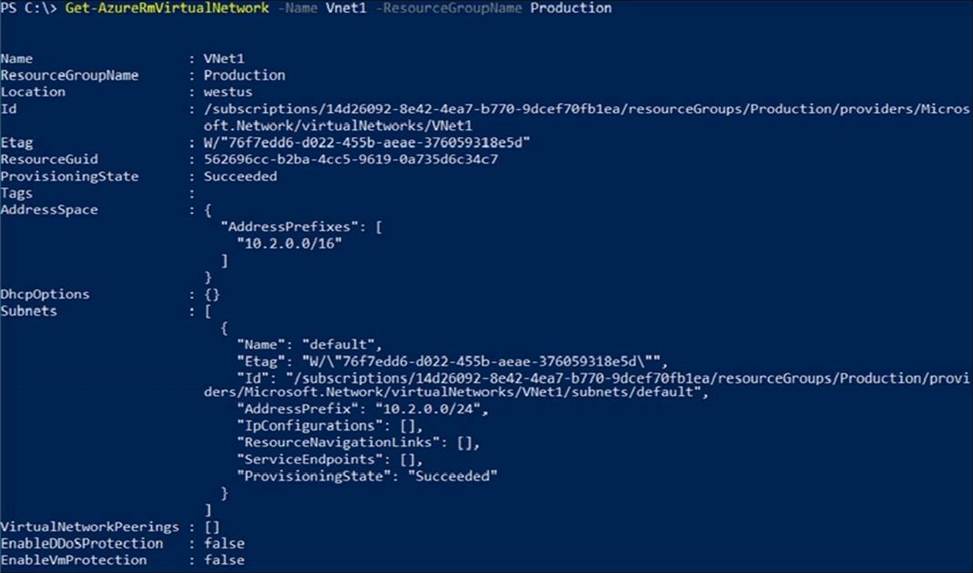
Use the drop-down menus to select the answer choice that completes each statement based on the information presented in the graphic. NOTE: Each correct selection is worth one point.


Explanation:
https://learn.microsoft.com/en-us/azure/virtual-network/manage-virtual-network#add-or-remove-an-address-range
HOTSPOT
You have an Azure subscription.
You deploy a virtual machine scale set that is configure as shown in the following exhibit.
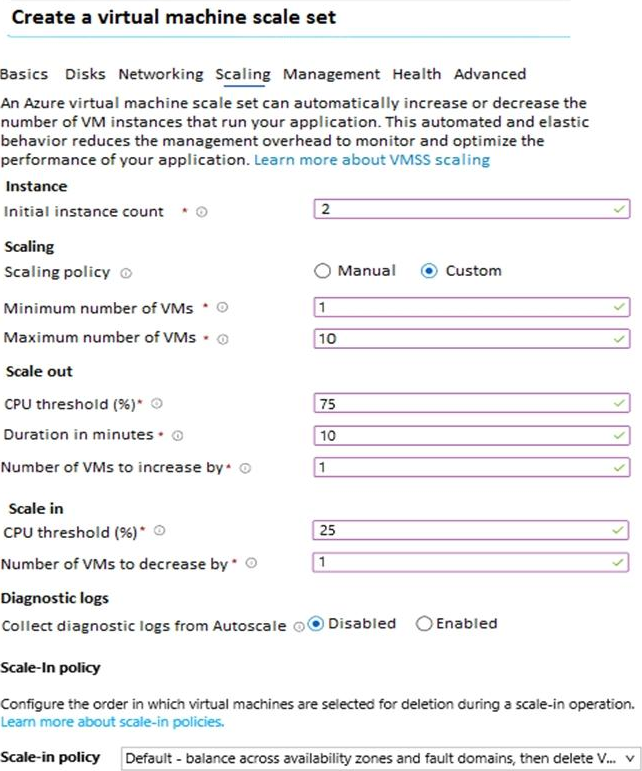
Use the drop-down menus to select the answer choice that answers each questions based on the information presented in the graphic. NOTE: Each correct selection is worth one point.
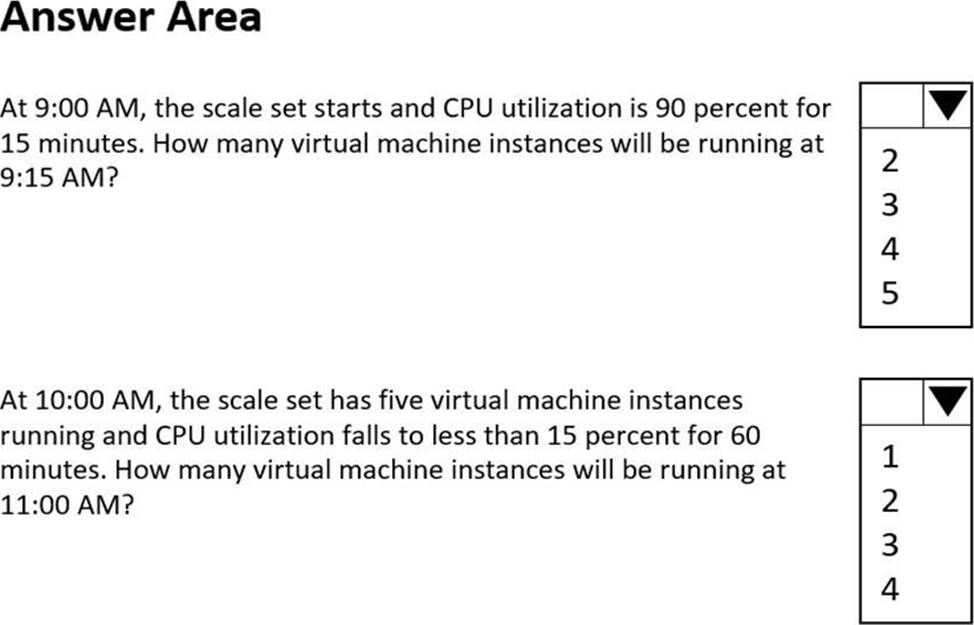
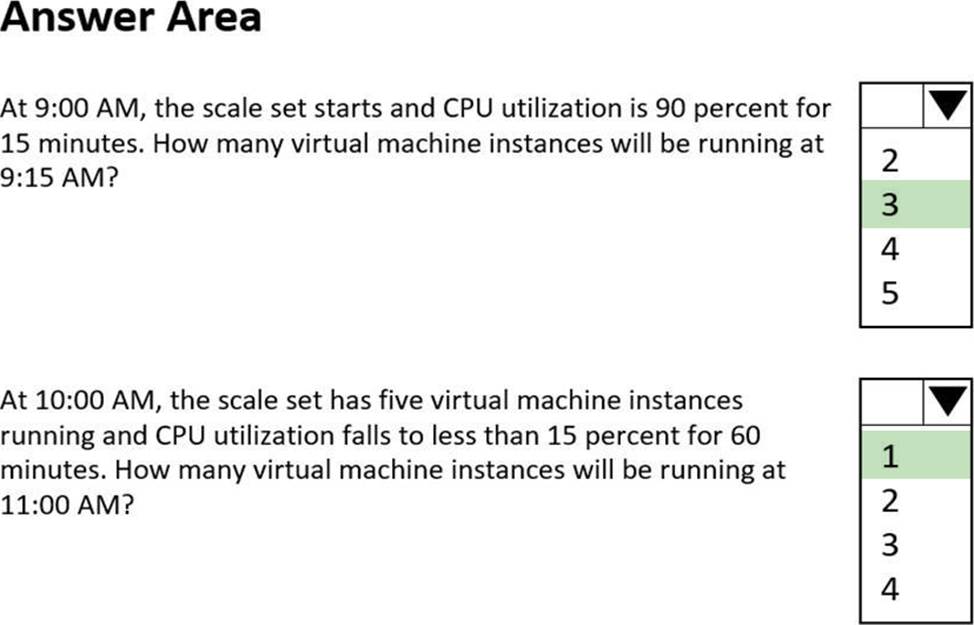
Explanation:
Box-1: 3
Initial starts 2 VM’s 15 minutes have passed. at 10 minutes 1 VM was added we now have 3 VM’s.
Cool down is 5 Minutes before another 10 minute wait cycle starts so the answer is 3.
Box-2: 1
Initial 5 VM’s 60 minutes Pass. 1 VM removed every 15 minute cycle. 10 minutes wait timer plus 5 minute cool down equals 15 minutes cycle. Four 15 minute cycles pass equaling 60 minutes removing 4 VM’s. We have 1 VM left.
Default Scale in and Out Default Durations are 10 minutes with 5 minute cool down.
The default scale set settings in Azure are:
-Minimum number of instances 1
-Maximum number of instances 10
-Scale out CPU threshold (%) 75
-Duration in minutes10
-Number of instances to increase by 1
-Scale in CPU threshold (%) 25
-Number of instances to decrease by -1
https://learn.microsoft.com/en-us/azure/virtual-machine-scale-sets/virtual-machine-scale-sets-autoscale-portal#create-a-rule-to-automatically-scale-in
HOTSPOT
You have an Azure subscription named Subscription1 that contains the virtual networks in the following table.

Subscripton1 contains the virtual machines in the following table.

In Subscription1, you create a load balancer that has the following configurations:
✑ Name: LB1
✑ SKU: Basic
✑ Type: Internal
✑ Subnet: Subnet12
✑ Virtual network: VNET1
For each of the following statements, select Yes if the statement is true. Otherwise, select No. NOTE: each correct selection is worth one point.


You have an Azure virtual machine named VM1.
You use Azure Backup to create a backup of VM1 named Backup1.
After creating Backup1, you perform the following changes to VM1:
Modify the size of VM1.
– Copy a file named Budget.xls to a folder named Data.
– Reset the password for the built-in administrator account.
– Add a data disk to VM1.
An administrator uses the Replace existing option to restore VM1 from Backup1.
You need to ensure that all the changes to VM1 are restored.
Which change should you perform again?
- A . Modify the size of VM1.
- B . Add a data disk.
- C . Reset the password for the built-in administrator account.
- D . Copy Budget.xls to Data.
D
Explanation:
The scenario mentioned in the question, we are using the replace option. So in this case we would lose the existing data written to the disk after the backup was taken. The file was copied to the disk after the backup was taken. Hence, we would need to copy the file once again.
Reference: https://docs.microsoft.com/en-us/azure/backup/backup-azure-arm-restore-vms#replace-existing-disks
